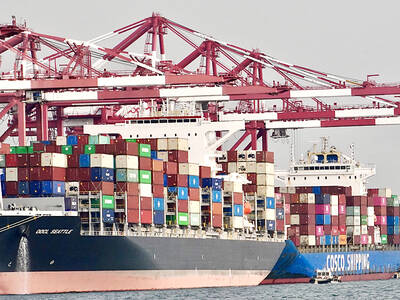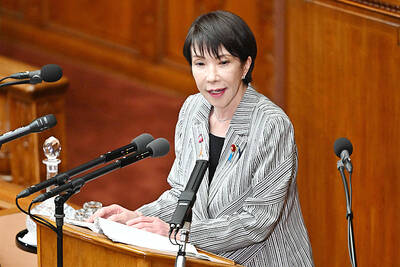The largest cultural exchange ever between Taiwan and China opened in Beijing yesterday with an exhibition of avant garde Taiwan-ese art.
"Visions of Pluralism: Contemporary Art in Taiwan, 1988-1999" by 75 Taiwanese artists is being shown at Beijing's Museum of Modern Art despite months of heightened tension.
Around 30 of the artists have come to the capital to show their works, some of which evoke Western pop art. One piece by Tang Huang-chen places two televisions beaming the same images opposite at each other.
Despite the crisis which erupted in July over President Lee Teng-hui's (李登輝) statement that Taipei-Beijing relations were conducted on a "special state-to-state" basis, the opening ceremony for the exhibition was formal, with China's vice minister of culture Meng Xiaosi attending.
"This exhibition had been planned for a year, well before the two-states theory row," explained Victoria Lu, a Taiwanese art critic and the show's curator. "We didn't know if it would go ahead or not, but the Taiwanese authorities were very supportive."
Although there are no official relations between the two governments, half of the show's cost was met by public funds from Taipei, Lu said.
Lin Cheng-chih (
"Culture is a means of dialogue that everybody understands," she said.
Lin cancelled his planned visit to Beijing at the last minute because of the 921 earthquake and not for political reasons, Lu said.
Exhibit organizers have done little to mask the fact that, except for a short period following World War II, the island has been politically separated from the mainland since the Japanese colonized it in 1895.
"Over 100 years of separation have generated undeniable differences between Taiwan and China," said Lu. "Separation from the mainland has endowed Taiwan with a very unique character and destiny."
She continued: "1988 was the beginning of a new era, in that it was the first year that the development of art became free from political control following the end of martial law in 1987."
The exhibition, which lasts 12 days, has received only sparse coverage by the mainland press.

Taiwan’s exports soared to an all-time high of US$61.8 billion last month, surging 49.7 percent from a year earlier, as the global frenzy for artificial intelligence (AI) applications and new consumer electronics powered shipments of high-tech goods, the Ministry of Finance said yesterday. It was the first time exports had exceeded the US$60 billion mark, fueled by the global boom in AI development that has significantly boosted Taiwanese companies across the international supply chain, Department of Statistics Director-General Beatrice Tsai (蔡美娜) told a media briefing. “There is a consensus among major AI players that the upcycle is still in its early stage,”

The Central Weather Administration (CWA) yesterday said it expected to issue a sea warning for Typhoon Fung-Wong tomorrow, which it said would possibly make landfall near central Taiwan. As of 2am yesterday, Fung-Wong was about 1,760km southeast of Oluanpi (鵝鑾鼻), Taiwan’s southernmost point, moving west-northwest at 26kph. It is forecast to reach Luzon in the northern Philippines by tomorrow, the CWA said. After entering the South China Sea, Typhoon Fung-Wong is likely to turn northward toward Taiwan, CWA forecaster Chang Chun-yao (張峻堯) said, adding that it would likely make landfall near central Taiwan. The CWA expects to issue a land

‘SECRETS’: While saying China would not attack during his presidency, Donald Trump declined to say how Washington would respond if Beijing were to take military action US President Donald Trump said that China would not take military action against Taiwan while he is president, as the Chinese leaders “know the consequences.” Trump made the statement during an interview on CBS’ 60 Minutes program that aired on Sunday, a few days after his meeting with Chinese President Xi Jinping (習近平) in South Korea. “He [Xi] has openly said, and his people have openly said at meetings, ‘we would never do anything while President Trump is president,’ because they know the consequences,” Trump said in the interview. However, he repeatedly declined to say exactly how Washington would respond in

Japanese Prime Minister Sanae Takaichi said yesterday that China using armed force against Taiwan could constitute a "survival-threatening situation" for Japan, allowing the country to mobilize the Japanese armed forces under its security laws. Takaichi made the remarks during a parliamentary session yesterday while responding to a question about whether a "Taiwan contingency" involving a Chinese naval blockade would qualify as a "survival-threatening situation" for Japan, according to a report by Japan’s Asahi Shimbun. "If warships are used and other armed actions are involved, I believe this could constitute a survival- threatening